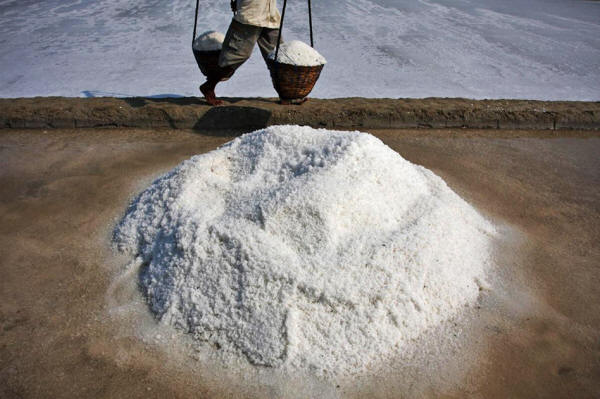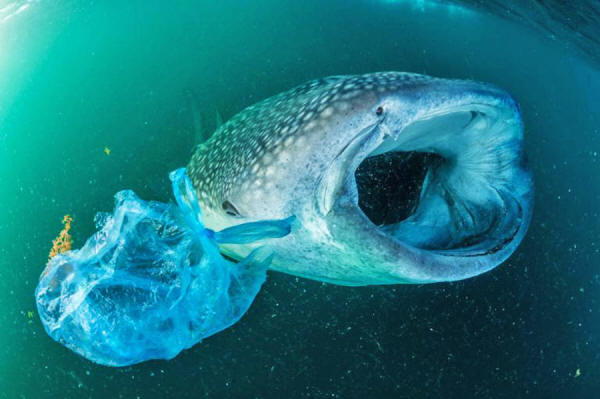|

by Laura Parker
October 17,
2018
from
NationalGeographic Website
Spanish equivalent version

Salt is produced on Madura Island, Indonesia,
by
evaporating seawater, an ancient technique.
A new
study found that salt made in this region
contains some of the highest microplastics sampled.
Photograph by Ulet Ifansasti, Getty Images
A new
study looked at
sea, rock, and
lake salt
sold around the
world.
Here's what you
need to know...
Microplastics were found in sea
salt several years ago.
But how extensively
plastic bits are spread throughout the most commonly used seasoning
remained unclear. Now, new research shows microplastics in 90
percent of the table salt brands sampled worldwide.
Of 39 salt brands tested, 36 had microplastics in them, according to
a new analysis by researchers in South Korea and
Greenpeace East Asia.
Using prior salt studies,
this new effort is the first of its scale to look at the
geographical spread of microplastics in table salt and their
correlation to where
plastic pollution is found in the
environment.
"The findings suggest
that human ingestion of microplastics via marine products is
strongly related to emissions in a given region," said
Seung-Kyu Kim, a marine science
professor at Incheon National University in South Korea.
Salt samples from 21
countries in,
-
Europe
-
North and South
America
-
Africa
-
Asia,
...were analyzed.
The three brands that
did not contain microplastics are from,
-
Taiwan (refined
sea salt)
-
China (refined
rock salt)
-
France (unrefined
sea salt produced by solar evaporation)
The study (Global
Pattern of Microplastics in Commercial Food-Grade Salts)
was published this month in the journal Environmental Science &
Technology.
The density of microplastics found in salt varied dramatically among
different brands, but those from Asian brands were especially high,
the study found.
The highest quantities of
microplastics were found in salt sold in Indonesia.
Asia is a hot spot for
plastic pollution, and Indonesia - with 34,000 miles (54,720 km) of
coastline - ranked in an unrelated
2015 study as suffering the
second-worst level of plastic pollution in the world.
In another indicator of the geographic density of plastic pollution,
microplastics levels were highest in sea salt, followed by lake salt
and then rock salt.
The new study is the fifth on salt published in recent years.
Others have been done by,
Sherri Mason, a professor at
the State University of New York in Fredonia, who partnered with
researchers at the University of Minnesota on a separate salt study,
said in an interview the new findings add "another piece to the
puzzle" to assessing the impact of microplastics.
"That fact that they
found higher counts in Asia is interesting. While not
surprising, you still have to have the data," she says.
"The earlier studies
found traces of microplastics in salt products sold in those
countries, but we haven't known how much."

A whale shark
swims
beside a plastic bag
in the
Gulf of Aden near Yemen.
Although whale sharks
are the
biggest fish in the sea,
they're
still threatened by ingesting
small
bits of plastic.
The new study, she says,
"shows us that
microplastics are ubiquitous. It's not a matter of if you are
buying sea salt in England, you are safe."
Is this
harmful?
The new study estimates that the average adult consumes
approximately 2,000 microplastics per year through salt. What that
means remains a mystery.
A separate study by the University of York in Britain that sought to
assess the risks of microplastics to the environment, published
Wednesday, concluded not enough is known to determine if
microplastics cause harm.
The review of 320 existing studies found "major knowledge gaps" in
scientific understanding of the impact of microplastics.
The studies examined
different types of microplastics, including,
-
microbeads
-
fragments
-
fibers,
...leading to a
"mismatch" of data that makes comparisons akin to comparing "apples
to pears," Alistair Boxall, a University of York geography
professor and co-author of the study, said in a statement.
"Based on our
analysis, there is currently limited evidence to suggest
microplastics are causing significant adverse impacts," he said.
"There is an urgent
need for better quality and more holistic monitoring studies
alongside more environmentally realistic effects studies on the
particle sizes and material types that are actually in the
environment."
That new study (Microplastics
in the Aquatic Environment - Evidence for or against Adverse Impacts
and Major Knowledge Gaps), funded by the Personal Care
Products Council (PCPC),
an industry trade group, was published in the journal
Environmental Toxicology and Chemistry.
Boxall added that the focus on microplastics may divert attention
from worse environmental (and more easily identifiable) pollution
problems, such as small particles released from car tires.
| 


